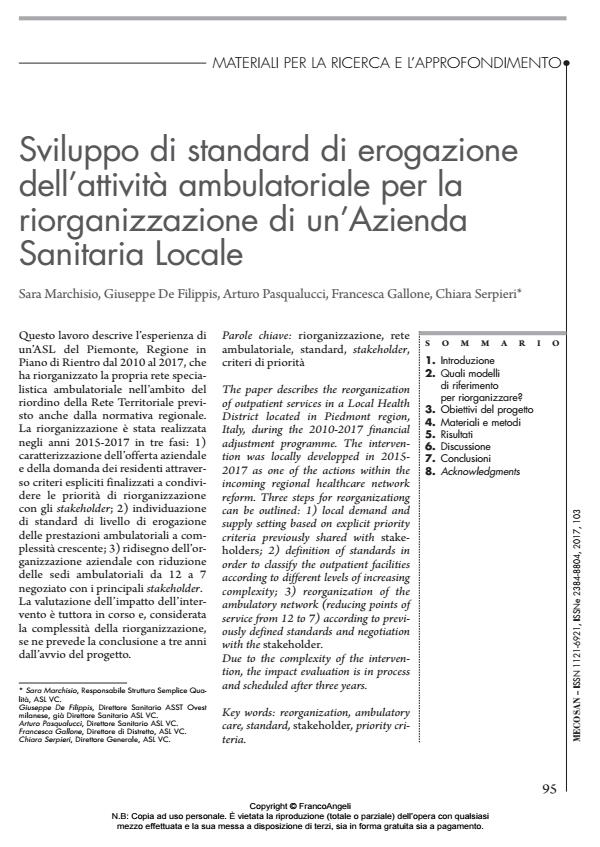Sviluppo di standard di erogazione dell’attività ambulatoriale per la riorganizzazione di un’Azienda Sanitaria Locale
Journal title MECOSAN
Author/s FIASO Federazione Asl e Ospedali
Publishing Year 2018 Issue 2017/103
Language Italian Pages 21 P. 95-115 File size 23941 KB
DOI 10.3280/MESA2017-103007
DOI is like a bar code for intellectual property: to have more infomation
click here
Below, you can see the article first page
If you want to buy this article in PDF format, you can do it, following the instructions to buy download credits

FrancoAngeli is member of Publishers International Linking Association, Inc (PILA), a not-for-profit association which run the CrossRef service enabling links to and from online scholarly content.
The paper describes the reorganizationof outpatient services in a Local HealthDistrict located in Piedmont region,Italy, during the 2010-2017 financialadjustment programme. The interventionwas locally developped in 2015-2017 as one of the actions within theincoming regional healthcare networkreform. Three steps for reorganizationgcan be outlined: 1) local demand andsupply setting based on explicit prioritycriteria previously shared with stakeholders;2) definition of standards inorder to classify the outpatient facilitiesaccording to different levels of increasingcomplexity; 3) reorganization of theambulatory network (reducing points ofservice from 12 to 7) according to previouslydefined standards and negotiationwith the stakeholder.Due to the complexity of the intervention,the impact evaluation is in processand scheduled after three years.
Keywords: Reorganization, ambulatorycare, standard, stakeholder, priority criteria
- Aguiar Valim Fo A.R., Mota I. (2012). Optimization models in the location of healthcare facilities: a real case in Brazil. Journal of Applied Operational Research, 4: 37-50.
- Barr B., Whitehead M. (2014). The impact of NHS resource allocation policy on heath inequalities in England 2001-11: longitudinal ecological study. British Medical Journal, 348: p. 3231.
- Chu S.C.K., Chu L. (2000). A modelling framework for hospital location and service allocation. International Transaction in Operational Research, 7: 539-568.
- Church R.L., Murray A.T. (2009). Business site selection, location analysis and GIS. New York: Wiley.
- Cremieux P-Y, Ouellette P, Pilon C. (1999). Health care spending as determinants of health outcomes. Health Economics, 8(7): 627-639.
- Cromwell I., Peacok S., Mitton C. (2015). Real world healthcare priority setting using explicit decision criteria: a systematic review of literature. Bio Med Cantral Health Service Research.
- Deming, W. Edwards (2000). Out of the crisis. Cambridge, Mass.: MIT Press. p. 88.
- Guerriero F., Miglionico G., Olivito F. (2016). Location and reorganization problems: The Calabrian healthcare system case. European Journal of Operational Research, 250: 939-954.
- Guindo L.A., Wagner M., Baltussen R., Rindress D., van Til J., Kind P. et al. From efficacy to equity: Literature review of decision criteria for resource allocation and healthcare decision-making. Cost Effectivness and Resource Allocation, 10(1): 9.
- Gulliford M., Figueroa-Munoz J., Morgan M., Hughes D., Gibson B., Beech R., Hudson M. J. (2002). What does ‘access to health care’ mean? Journal of Health Service Research & Policy, 7(3): 186-188.
- Kapiriri L., Norheim O.F., Martin D.K. (2009). Fairness and accountability for reasonableness. Do the views of priority setting decision makers differ across health systems and levels of decision making? Social Science & Medicine, 68(4): 766-773.
- Martin S., Rice N., Smith P.C. (2008). Does health care spending improve health outcomes? Evidence from English programme budgeting data. Journal of Health Economics, 27(4): 826-842.
- Mitton C., Donaldson C. (2004). Health care priority setting: principles, practice and challenges.
- Cost Effectiveness and Resources Allocation, 2: 3. Moen, R.D., Norman C.L. (2010). Circling back: Clearing up myths about the Deming cycle and seeing how it keeps evolving. Quality Progress, 43(11): 21-28.
- Nixon J., Ulmann P. (2006). The relationship between health care expenditure and health outcomes: evidence and caveats for a causal link. European Journal of Operational Research, 7: 7-18.
- Patten S., Mitton C., Donaldson C. (2005). From the trenches: views from decision-makers on health services priority setting. Health Service Management Resource, 18(2): 100-108.
- Peacock S., Ruta D., Mitton C., Donaldson C., Bate A., Murtagh M. (2006). Using economics to set pragmatic and ethical priorities. British Medical Journal, 332(7539): 482-485.
- Regione Piemonte, Programma Operativo 2013- 2015 predisposto ai sensi dell’art. 15, comma 20, del D.L. n. 95/2012 convertito, con modificazioni, in Legge n. 135/2012: Deliberazione della Giunta Regionale 30 dicembre 2013, n. 25-6992. “Approvazione Programmi Operativi 2013-2015 predisposti ai sensi dell’art. 15, comma 20, del D.L. n. 95/2012 convertito, con modificazioni, in legge n. 135/2012”.
- Regione Piemonte. Comunicato Stampa, 29 novembre 2016. “Assistenza territoriale, la Regione Piemonte investe 8 milioni per una rete diffusa di 54 Case della Salute”. Regione Piemonte. DCR n. 616-3149 del 22.02.2000 Manuale per l’accreditamento delle strutture sanitarie pubbliche e private. Regione Piemonte. Deliberazione della Giunta Regionale 23 aprile 2014, n. 15-7486. “Assistenza specialistica ambulatoriale: attuazione punto 14.3.4 dei Programmi operativi per il triennio 2013-2015 di cui alla D.G.R. n. 25-6992 del 30.12.2013”. Regione Piemonte. Deliberazione della Giunta Regionale 16 maggio 2016, n. 35-3310 “Disciplina della Chirurgia Ambulatoriale Complessa. Individuazione dei requisiti strutturali, tecnologici ed organizzativi dell’attivita e modalita applicative”. Smith N., Mitton C., Peacock S., Cornelissen E., MacLeod S. (2009). Identifying research priorities for health care priority setting: a collaborative effort between managers and researchers. Bio Med Central Health Services Research, 9: 165.
- Ozcan Y.A. (2005). Quantitative Methods in Health Care Management: Techniques and Applications. San Francisco: Jossey-Bass. -- https://books.google.it/books?id=zPeCLkDcIlAC&pg=PA154&lpg=PA154&dq=standard+of+care+and+reallocation&source=bl&ots=NUs-GYK2pv&sig=2SKsp97h5BdYG8PxhkORcM3n0Q4&hl=it&sa=X&ved=0ahUKEwjKwZqX9svPAhVJVhQKHfF8C
- Outsourcing, Delocalization and Firm Organization: Transaction Costs vs. Industrial Relations in a Local Production System of Emilia Romagna Massimiliano Mazzanti, Sandro Montresor, Paolo Pini, in SSRN Electronic Journal /2007
DOI: 10.2139/ssrn.1010304
FIASO Federazione Asl e Ospedali, Sviluppo di standard di erogazione dell’attività ambulatoriale per la riorganizzazione di un’Azienda Sanitaria Locale in "MECOSAN" 103/2017, pp 95-115, DOI: 10.3280/MESA2017-103007